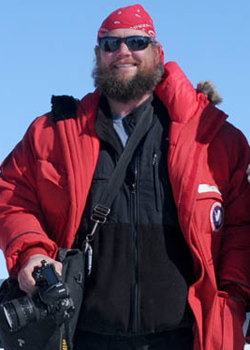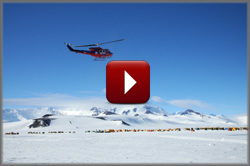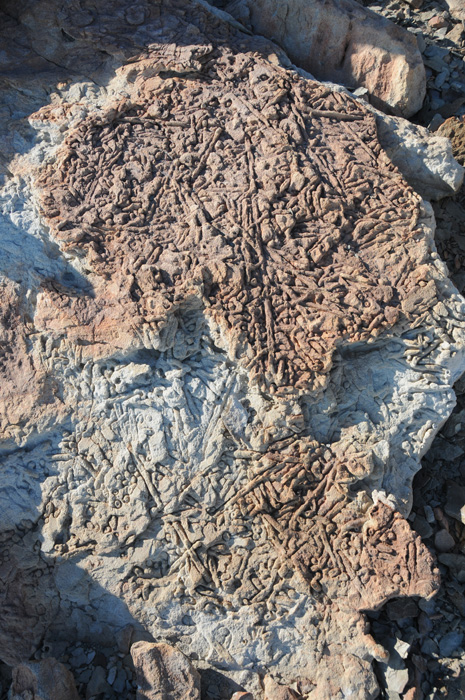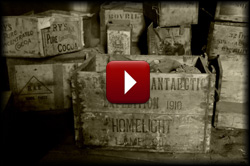Traces in Time
April 28, 2011

When Peter Flaig returned home from Antarctica, he found it pretty amusing that the city of Austin was shut down by an inch of snow, a little bit of ice, and low temperatures in the 20s. The university was closed, as were public schools and many businesses and government agencies. But in what can be one of the harshest environments on Earth, he and dozens of other scientists had just had a stellar field season with highs in the 20s and more than their share of snow and ice.
“It was one of the most productive field seasons I’ve had as a geologist,” said Flaig, a post doctoral researcher at the Bureau of Economic Geology, a research unit in the University of Texas at Austin’s Jackson School of Geosciences. “We had very little downtime because of weather, allowing us to collect enormous amounts of samples and data.”
He said it’s not uncommon in Antarctica to lose half a season to bad weather, which grounds helicopters and planes, leaving you sitting in a tent playing cards, writing letters, and organizing photos and data. But apart from a storm that delayed their initial trip out into the field, they were able to fly and do their research every day.
“Although it drove us crazy to stay in camp one sunny day when we could have done great research,” he said, “we had to take ourselves off of the helicopter schedule just to organize our piles of samples and pack them away to be airlifted out of camp.”

At times, as many as 80 scientists and support staff were working at the temporary field station in the Transantarctic Mountains near Beardmore Glacier, making it the second largest “city” in Antarctica. Flaig was part of a team looking for trace fossils-signs of animal life such as tracks, nests, burrows or slithery drag marks. A sedimentologist by training, Flaig was there to help work out what the environment was like at the time these traces were made. The team was led by Stephen Hasiotis, a trace fossil expert at the University of Kansas.
The scientists were lured to this site by the promise of rocks exposed at the surface from a time and place that are extremely rare.
One of the most earth-shattering events in the planet’s history, at least from the perspective of living things, was the granddaddy of all mass extinctions at the end of the Permian Period and beginning of the Triassic Period about 250 million years ago. Rocks that formed as sea-floor sediments show that most ocean dwelling organisms died out then.
The picture of what happened to life on land is much foggier. That’s because very few rock exposures have been found that contain terrestrial sites with sediments of this age. Even fewer sites show a continuous record on land from before, during and after the extinction event. Flaig and Hasiotis studied one nearly continuous succession across this boundary and several other remarkably detailed terrestrial successions containing rocks from the Permian and Triassic.
“We wanted to see what types of critters were living in Antarctica at that time, and if there was a change in the trace fossil record across that extinction event,” said Flaig.
They made some dramatic discoveries, such as the first evidence of horseshoe crabs in Antarctica, whose presence was given away by delicate footprints in shallow, muddy floodplain lakes. Their actual bodies were too soft to be preserved.
“You don’t often find fossils of soft things like worms, insects or crabs,” he said. “All you typically get are their tracks and trails. This is why studying trace fossils is so important.”

Another surprise: they found evidence of marine animals where they didn’t expect to find them.
“We found sediments and trace fossils likely deposited in a shallow ocean where people once thought there was a large lake,” said Flaig.
The discovery of the first vertebrate fossil in Antarctica in 1967, very near the Beardmore Glacier camp, sparked much of the research that continues today in the area. Flaig and Hasiotis were especially excited this year to find over a dozen large burrows made by mammal-like reptiles during the Triassic, that is, after the mass extinction.
“That was a big deal,” he said. “Almost everywhere vertebrate fossils were found, we found burrows, often with scratch marks still on them. That’s important because burrowing is a survival mechanism for these animals. It says something about the environment and the climate. To have both the dwellings and the animals responsible for making them preserved together in the same place-sometimes right next to each other-is just thrilling.”
In addition to big changes in life on the planet, the sedimentary rocks at this site record big changes in climate. Earth at this time went from an icehouse to a greenhouse. During the Early Permian, glaciers covered much of Antarctica. Then, as Earth warmed in the Late Permian and Triassic, they retreated, making way for more temperate plants and animals. In this latest field season, Flaig and his colleagues from the University of Kansas discovered a forest of fossil trees more extensive and denser than previously known, a testament to that warmer time. Some were charred by wildfires, probably started by lightning.
“You can stand there and there is not a [live] tree for thousands of miles,” he said. “I’ve done this job for 15 years now and it still just blows my mind. I keep taking pictures of it. Logs, stumps and fallen trees with ice as far as you can see.”
Flaig said when you turn the clock back, taking into account how the continental plates have moved, Antarctica was probably about as far south then as it is now. Yet it was covered in forest.
“That’s amazing,” he said. “This change from a forested Antarctica to the ice covered continent we see today is something that happened naturally, before humans were around. I’d like to know why that is. Why does the Earth go through these warming and cooling cycles, how often does this happen and how is this expressed in the rock record?”

Every seven to ten years, dozens of scientists converge on this same remote spot for a concentrated field season. The logistics are mind boggling. Huge C130 military aircraft bring in everything the temporary scientific village needs-portable buildings for housing and labs, tractors, snowmobiles, generators, fuel and food. Crews build runways on the ice and set up communications equipment. A couple of months later, it’s all torn down and flown back out to McMurdo Station, the U.S. research station and base of operations in Antarctica.
Flaig was in Antarctica for the last camp in the Transantarctic Mountains as part of his master’s field work in 2003. He said people keep returning to the same spot because there’s so much good science that can still be done there. Thanks to lava that squeezed in between otherwise brittle sedimentary layers, creating a sandwich with lava on top and sedimentary rocks in the middle, the fragile paleoclimate record has been well preserved in mountains that stick up above the ice.
It’s so expensive to work in Antarctica and it takes so long to get the grants and assemble the teams and equipment to mount an expedition that most people don’t want to risk everything on unknown sites. Having a group of different scientists with different objectives in the same area allows teams to share daily results and offer suggestions to each other about where to look for things. Plus, the more people are there, the more cost effective it is for each group and the easier to organize logistics.
“If I wanted to go to Beardmore Glacier by myself, they would fly me out there, drop me and my team on the ice with snowmobiles and some tents and say, good luck,” he laughed. “But to get to the locations I really want to get to, I need a helicopter. And they aren’t going to devote a helicopter just to me.”
by Marc Airhart
For more information about the Jackson School contact J.B. Bird at jbird@jsg.utexas.edu, 512-232-9623.
